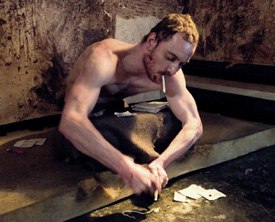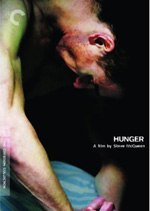This bleak tale of the IRA's protest strikes in British prisons is like three short films in one. Various characters float in and out of the three sections, making the film more of an experience of a place and time than a traditional narrative. This compels the audience because director Steve McQueen has quiet patience that draws us in and then grabs the viewer by the eyeballs with harsh realism.
The film begins with Davey Gillen (Brian Milligan, THE BOXER) introduced to prison life. He refuses to wear the prison uniform, because he believes he is not a criminal. Stripped naked, given only a blanket, he is put in a cell with Gerry Campbell (Liam McMahon, SNATCH), who too only wears a blanket. Campbell has smeared feces all over the walls as part of the Irish no wash protest. With little to no dialogue, the film watches as their loved ones smuggle items to them and the British guards beat them and even subject some to forceful rectal searches.
Eventually, the leader of the IRA prisoners, Bobby Sands (Michael Fassbender, INGLOURIOUS BASTERDS) is drug from his cell and is given a bath and haircut against his will. In the process, he spits in the face of the conflicted guard Raymond Lohan (Stuart Graham, TV's THE CLINIC), who at the beginning of the film we see with his wife in a peaceful domestic setting. A shot of him casually wiping crumbs off his lap at breakfast is a stark remind of the difference between is life and those of his prisoners. When the IRA's request for civilian clothes is granted, the British give them clownish attire from the 1970s. This marks the first section of the film.
The middle is an extended conversation between Sands and the priest Dominic Moran (Liam Cunningham, THE WIND THAT SHAKES THE BARLEY). Sands has decided that he will be the first of a list of IRA prisoners to engage in a hunger strike. Moran argues the morality of virtually committing suicide as a form of protest. Sands cannot be persuaded against it. For him, there is a point where a person's people are suffering with no hope of change that a true believer has to be willing to make the ultimate sacrifice to prove how serious the cause is. He doesn't care what happens to him, only how it will help his friends in the grand scheme. This is the second section.
The third and final section is the physical ramifications of the hunger strike on Sands' body. He becomes rail thin and his organs start giving out one by one. If one isn't impressed with Fassbender's performance during the monologue heavy middle sequence, you have to be impressed with his dedication to his craft, knowing he went from 170 to 132 lbs for the role. Following this film and INGLOURIOUS BASTERDS, he has become a hot actor in Hollywood. He provides this artistic experiment with a guttural emotion that is moving.
McQueen and cinematographer Sean Bobbitt bring an ethereal beauty to the raw images. With the film's quiet tempo, the imagery creates a disquiet that envelops somberness over the entire film. It works perfectly with the message at hand.
Despite the Hollywood pedigree his name evokes, McQueen is a British fine artist who primarily works in photography and video installations. The artistic quality of museum pieces comes through in his first feature film. HUNGER is meant to evoke emotions and thoughts in its viewer. Sands was the first of nine other IRA members to die in the hunger strike. Margaret Thatcher's government eventually relented and quietly gave into the Irish demands. In a provocative way, the film gets to the soul of what motivates a hunger striker. In their eyes what is the difference facing certain death on the battlefield or in a British prison by not taking food? The latter actually takes more dedication.










